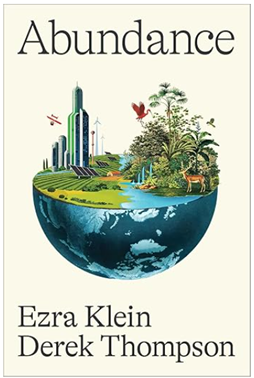By Jim Heffernan
I was attracted to this book by a New York Times review with the headline, “Can Democrats Learn to Dream Big Again?” I think that reviewer was wrong to limit the need for “dreaming big again” to one party.
Neither of the parties have the ability to “dream big” anymore. They have become the parties of “Trump” and “Not Trump”. The tragedy of our time is that fully a third of American voters are so disgusted by the spectacle that they fail to vote. We are now governed by a 30% segment of voters who masquerade as a majority.
The book title comes from the authors’ belief that we should replace our current politics of scarcity with a politics of abundance.
I am among the oldest of “baby boomers.” I have seen the shift from “abundance” to “scarcity” play out in my lifetime.
I spent the first 25 years of my life controlled by my parents or by the military. When I became independent in 1971, “abundance” was in my grasp. In the years since then, “abundance” has been continuously replaced by “scarcity.”
In 1971, I had a medium wage job and I earned $800 a month. I was able to buy a 930 sq. ft., 3 bedroom house for $14,500. Because I could qualify as VA, I only had to put down $99 to move in. My mortgage was $145 a month. My income was enough that we didn’t need to have a second job in the family or worry about daycare for our two toddlers.
In 1972, I spent a year going to college. VA paid me a stipend of $435 a month. It was basically what I might earn in a minimum wage job of the time. The $435 dollar check was enough to pay for a semester’s (10 semester hours) tuition at University of Colorado at Denver, buy my textbooks and treat the family to burgers at Dairy Queen.
In 1972, I drove a taxi to make enough money to survive. I was left without health insurance, but was able to buy coverage from Kaiser for $135 a month. It was a burden, but I felt better with health coverage for our family than without.
The book focuses on four areas: (i) the need for land use reform to build more housing and lower the cost, (ii) the massive amount of infrastructure that needs to be built for clean energy to be able to electrify everything (iii) the need to build state capacity (the ability of a state to accomplish its goals), and (iv) investing in science and innovation, including making sure existing dollars go further by, for example, funding earlier-stage scientists doing higher-risk research.
The book does a wonderful job in identifying the causes of our drift into a political and social climate of “scarcity.” I think it comes up short in defining our solutions.
That’s understandable, our solutions involve a massive transformation of ourselves and our government. With a third of us worshipping Donald Trump, a third of us despising him, and a third of us just not caring, I’m not sure a solution possible.
I’ll keep hoping for a reform in citizenship or religion to save us from a future where people like me and my grandchildren have smaller and smaller pieces of the freedoms that FDR promoted in his second bill of rights.
Here are some excerpts from the book.
“When you make legal training the default training for a political career, you make legal thinking the default thinking in politics. And legal thinking centers around statutory language and commitment to process, not results and outcomes.” Page 93
“The Interstate Highway System is forty-nine thousand miles of road. The interstate clean-energy system—the solar farms, the wind turbines, the geothermal land, the transmission lines, the pipes—will touch more than five hundred thousand miles of land.” Page 95),
“When we claim the world cannot improve, we a stealing from the future something invaluable, which is the possibility of progress. Without that possibility, progressive politics is dead. Politics itself becomes a mere smash-and-grab war over scarce goods, where one man’s win implies another man’s loss.” Page 134
“Political movements succeed when they build a vision of the future that is imbued with virtues of the past. Franklin D. Roosevelt pitched his expansive view of government as a sentinel for American freedoms- of worship, from want, from fear. Five decades later, Reagan hailed the same virtues, this time by casting government as freedom’s nemesis rather than its protector.” Page 221
288 Pages (65 notes, index and discussion questions) Published 3/18/2025
Book is available at Cloud and Leaf Bookstore, Manzanita and Tillamook County Library
As always, discussion welcome at codger817@gmail.com


